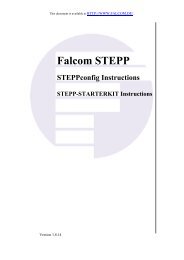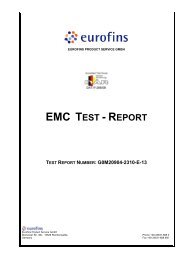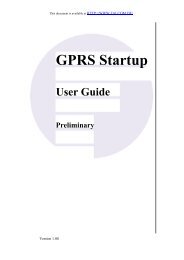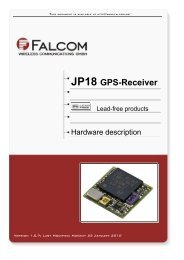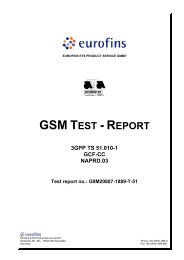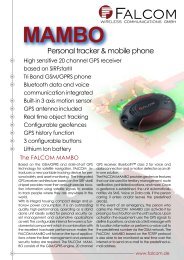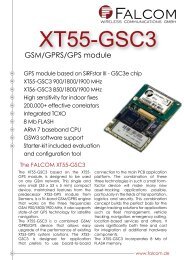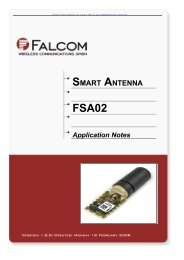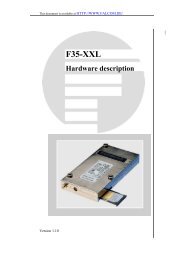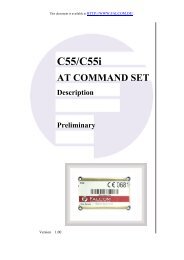You also want an ePaper? Increase the reach of your titles
YUMPU automatically turns print PDFs into web optimized ePapers that Google loves.
This document is available at http://www.falcom.de/ .<br />
Version 1.02, 19/09/2005<br />
<strong>Interrupt</strong> <strong>control</strong><br />
Application Note
Application note Version 1.02<br />
Index of contents<br />
0 INTRODUCTION.......................................................................5<br />
0.1 UART’S .................................................................................................................................5<br />
0.2 ASIC INTERRUPTS ....................................................................................................................5<br />
0.3 TIMER INTERRUPT ......................................................................................................................5<br />
0.4 UART INTERRUPT .....................................................................................................................6<br />
0.5 GPIO LINES ...........................................................................................................................6<br />
0.5.1 The Real Time Clock..........................................................................................................9<br />
0.5.2 <strong>Interrupt</strong>s .............................................................................................................................9<br />
0.5.3 BUS Interface......................................................................................................................9<br />
0.6 CHIP SELECT WAIT STATES ........................................................................................................9<br />
0.7 DIGITAL CHIP ADDRESS SPACE..................................................................................................9<br />
0.8 INTERRUPT CONTROL MODULE............................................................................................... 11<br />
0.8.1 <strong>Interrupt</strong> Controller Functional Description ................................................................ 12<br />
0.9 BIU CHIP SELECT REGISTERS .................................................................................................. 12<br />
0.10 PAUSE CONTROL FUNCTION.................................................................................................. 12<br />
0.11 INTERRUPT CONTROLLER REGISTER MAPPING .......................................................................... 13<br />
0.12 PULSE INTERRUPT MANAGEMENT ............................................................................................ 14<br />
0.13 DATA_READY INTERRUPT ....................................................................................................... 14<br />
0.14 UART INTERRUPT .................................................................................................................. 15<br />
0.15 TIMER INTERRUPTS.................................................................................................................. 16<br />
0.16 TIMER INTERRUPT ACKNOWLEDGE .......................................................................................... 16<br />
0.16.1 Beacon <strong>Interrupt</strong> ............................................................................................................ 16<br />
0.16.2 External <strong>Interrupt</strong> Active Level...................................................................................... 17<br />
0.16.3 UARTModule.................................................................................................................... 17<br />
1 THREE- WIRE INTERFACE .......................................................21<br />
1.1 THREE-WIRE MASTER MODE .................................................................................................. 22<br />
1.1.1 Three-Wire Slave Mode ................................................................................................. 22<br />
1.2 GPIO ................................................................................................................................. 24<br />
1.2.1 GPIO Sel ........................................................................................................................... 25<br />
1.2.2 GPIO State....................................................................................................................... 26<br />
1.2.3 GPIO PortVal ................................................................................................................... 27<br />
1.2.4 GPIO PortDir..................................................................................................................... 28<br />
1.3 INPUTS/OUTPUTS ................................................................................................................... 28<br />
1.4 SCHEMATICS OF VARIOUS GPIO PIN CONFIGURATIONS ......................................................... 29<br />
1.5 EVAL-BOARD LED ACTIVATION............................................................................................. 31<br />
1.6 USED ABBREVIATIONS ............................................................................................................ 32<br />
This confidential document is the property of FALCOM GmbH and may not be copied or circulated without permission.<br />
Page 2
Application note Version 1.02<br />
Version history:<br />
Version number Author Changes<br />
1.00 Fadil Beqiri - Initial version<br />
1.01 Fadil Beqiri - Table 1 in chapter 0.5 updated.<br />
1.02 Fadil Beqiri - Chapter 1.3 added (functions for inputs/outputs).<br />
This confidential document is the property of FALCOM GmbH and may not be copied or circulated without permission.<br />
Page 3
Application note Version 1.02<br />
Cautions<br />
Information furnished herein by FALCOM are accurate and reliable. However, no<br />
responsibility is assumed for its use.<br />
Please, read carefully the safety precautions.<br />
If you have any technical questions regarding this document or the product<br />
described in it, please contact your vendor.<br />
General information about FALCOM and its range of products are available at the<br />
following Internet address: http://www.falcom.de/<br />
Trademarks<br />
Some mentioned products are registered trademarks of their respective companies.<br />
Copyright<br />
This description is copyrighted by FALCOM GmbH with all rights reserved. No part of<br />
this user’s guide may be produced in any form without the prior written permission of<br />
FALCOM GmbH.<br />
FALCOM GmbH.<br />
No patent liability is assumed with respect to the use of the information contained<br />
herein.<br />
This confidential document is the property of FALCOM GmbH and may not be copied or circulated without permission.<br />
Page 4
Application note Version 1.02<br />
0 INTRODUCTION<br />
The ARM7TDMI Microprocessor integrated to the <strong>Falcom</strong> GPS receiver is a member<br />
of the Advanced RISC Machines (ARM) family of general purpose, 32-bit<br />
microprocessors, which offer high performance for very low power consumption and<br />
price. The ARM7TDMI runs at a maximum speed of 50 MHz to deliver about 40 million<br />
instructions per second.<br />
The Module Interface (MI) module is available as object code and provides an<br />
interface mechanism between the GPS Core and the User Interface (UI) Module<br />
<strong>control</strong>ling the I/O protocol for communicating with external devices. In general, the<br />
UI is driven by events that are signaled by the GPS Core. When these events are<br />
received, the generic UI manager code determines the current protocol and calls<br />
an appropriate function in that protocol to handle the event. Inside the current I/O<br />
protocol, the event may signal that system information is supposed to be output.<br />
0.1 UART’S<br />
The embedded internal GPS receiver into the XF55-AVL and STEPP II devices provides<br />
two full duplex serial ports that are typically used for the following purposes:<br />
� Port 1: GPS serial data output and receiver <strong>control</strong><br />
� Port 2: Reception of differential corrections (the STEPP II terminal uses this<br />
port to communicate with the GSM serial port)<br />
Both UARTs are full duplex with both transmit and receive sides containing a 16-byte<br />
deep FIFO. The Baud rates on both channels are independently selectable from<br />
1200 bps to 115.2 kbps. The parity, data bits and stop bits are also configurable. Each<br />
receive register provides error signals for frame error, parity error, and break interrupt.<br />
0.2 ASIC <strong>Interrupt</strong>s<br />
The satellite signal tracking loop processing is handled by the satellite signal tracking<br />
engine (SSTE) implemented in hardware. The fastest periodic interrupt generated by<br />
the embedded receiver is at a 100 ms rate. This rate is greatly reduced compared to<br />
the previous generations of GPS ASICs requiring 1 ms interrupt servicing. As a result of<br />
this, the software scheduler currently runs at a maximum rate of 10 Hz (100 ms). The<br />
digital part of embedded receiver is still capable of generating both 1 ms and 20 ms<br />
interrupts. The embedded receiver has two interrupt levels, IRQ and FIQ, with FIQ<br />
being the highest. All ASIC interrupts are generated on the same ARM IRQ interrupt<br />
level.<br />
0.3 Timer <strong>Interrupt</strong><br />
Timer interrupts are generated periodically based on the system clock (different from<br />
the processor clock). The timing of this interrupt is <strong>control</strong>led by software. Currently it<br />
is set at 100 ms which is the minimum rate fully supported by the Satellite Signal<br />
Tracking Engine, or Tracker (SSTE). The GPS software tasks are scheduled from this<br />
interrupt handler, including the 100 ms task, the 1 Hz execution task, and the<br />
background task (scheduled at 1 Hz). The 100 ms task performs processing of<br />
measurement data of channels that are tracking, or processing of reacquisition data<br />
if the channels are in search. The 1 Hz execution task <strong>control</strong>s the receiver manager,<br />
This confidential document is the property of FALCOM GmbH and may not be copied or circulated without permission.<br />
Page 5
Application note Version 1.02<br />
50 bps data processing, navigation, and user interface through the serial<br />
communication port.<br />
0.4 UART <strong>Interrupt</strong><br />
UART interrupts are generated by the UART on the ASIC whenever there is data to be<br />
transmitted or data is received. The processing of these interrupts is done by the<br />
UART functions. These functions call the appropriate transmit or receive processing<br />
for UART A and/or UART B. The data is buffered and passed to the application layer<br />
(user interface) after the GPS core has signaled a MI_EV_NAV_COMPLETE or<br />
MI_EV_WAIT_INITIAL_ACQ event.<br />
0.5 GPIO Lines<br />
The XF55-AVL provides 16 GPIO lines, whereas the STEPP II terminal provides 4 GPIO<br />
lines. Most GPIO pins are multi-functional and are often used for other purposes.<br />
Examples include chip selects, debugging support pins, microwire interface and<br />
external interrupts. Some of the GPIO lines are also used for power <strong>control</strong> during Low<br />
Power operation and may not be available. To enable the alternate function(s) of a<br />
GPIO, the ASIC_GPIO_SEL( 0x80010100) register must be modified. For<br />
information on how the Eval-Board LEDs are <strong>control</strong>led using GPIO lines see “Eval-<br />
Board LED Activation” chapter 1.5.<br />
�<br />
One of the first actions is to initialize the GPIO_SEL register (0x80010100).<br />
GPIO_SEL is also referred to as ASIC_GPIO_SEL. The GPIOs select<br />
register is declared in the PORTS.H extended file, and is mapped from<br />
ASIC_BASE_ADDR (0x80000000) + 0x10100.<br />
Tables 1 and 2 below list the GPIO lines and their alternate functions for the<br />
embedded GPS receiver. The Alternate Enable Bit is the bit in the ASIC_GPIO_SEL<br />
that must be set high to enable the alternate function. When alternate input is not<br />
selected, the default input is specified in the Default Alternate Input Value column.<br />
On most GPIO lines, either a pull-up or pull-down resistor is built into the chip of<br />
receiver.<br />
PIN<br />
Name<br />
Default<br />
alternative<br />
input Value<br />
Internal Pull-<br />
NOTE<br />
up/ Pull-down STEPPII XF55-AVL<br />
GPIO0 0 Pull down This pin (as an input one) is internally<br />
wired to the micro<strong>control</strong>ler. Nitron<br />
micro<strong>control</strong>ler response for the shutdown<br />
of GPS processor.<br />
PIN 32<br />
GPIO1 0 Pull down A watchdog logic implemented in the<br />
micro<strong>control</strong>ler periodically receives low<br />
pulses from the this GPIO1-pin, which is<br />
internally wired to the micro<strong>control</strong>ler. The<br />
low pulses have to be sent to the GPIO1pin.<br />
These alternate pulses allow the<br />
STEPP II device to maintain itself in the<br />
normal operation mode. If these alternate PIN 31<br />
pulses fail to arrive the watchdog<br />
GPIO2 0 Pull down<br />
periodically (at least a 100 ms pulse within<br />
120 seconds time interval, recommended<br />
a 100ms pulse every second), the STEPP<br />
II terminal forces internally a reset. The<br />
GPIO1 pin has to be programmed as an<br />
output pin.<br />
- -<br />
This confidential document is the property of FALCOM GmbH and may not be copied or circulated without permission.<br />
Page 6
Application note Version 1.02<br />
GPIO3 - Pull down The GPIO3-pin is internally linked to the<br />
GSM_ON pin of the GSM part. By<br />
powering up the module the direction of<br />
GPIO3 has to be programmed as an<br />
output and set to high level (it enables the<br />
GSM engine to be switched on). To set<br />
the GSM_ON pin to low level, the value of<br />
GPIO3 signal has to be set to low for at<br />
least 20 seconds.<br />
The GPIO3-pin is internally<br />
linked to the GSM_ON pin<br />
(PIN 66) of the GSM part.<br />
GPIO4 - None The GPI04 line is <strong>control</strong>led by the internal GPS software and should not<br />
be programmed (steered) by the user; otherwise the GPS receiver will be<br />
not functional. This pin steers the RF-Front (analogue part) of GPS<br />
receiver and is defaulted to logic HIGH at power up.<br />
GPIO5 0 Pull down D/A converter IN PIN 30<br />
GPIO6 - Pull down D/A converter OUT PIN 29<br />
GPIO7 0 Pull down D/A converter - CLK PIN 28<br />
GPIO8 - None The GPI08-line is <strong>control</strong>led by the internal GPS software, and it should<br />
not be programmed (steered) by the user; otherwise the GPS receiver will<br />
be not functional. This pin is connected to the RF regulator (analogue<br />
part) of GPS receiver and is defaulted to logic HIGH at power up.<br />
GPIO9 - Pull down The GPI09 line is predefined on the software as output (known as<br />
T_MARK pin on the GPS receiver.) This pin is active HIGH each second<br />
(povides 1 pulse per second), which is synchronized to within 1<br />
microsecond of GPS time.<br />
GPIO10 1 Pull up CS EPROM PIN 27<br />
GPIO11 1 Pull up - -<br />
GPIO12 1 Pull up - -<br />
GPIO13 - Pull up - -<br />
GPIO14 - Pull up - -<br />
GPIO15 - Pull up CS D/A converter PIN 26<br />
Table 1: Lists of the GPIO lines<br />
Please note that, in the table 2 the “Set Bit X to Y” means the X-th bit counting<br />
begings from 0, and from right to left. For more details, see chapter 1.2.<br />
PIN Name<br />
Set<br />
Alternate/GPIO<br />
function<br />
Set Direction (Input/Output)<br />
GPIO0 Register<br />
ASIC_GPIO_PORTDIR0= 80010134<br />
As Input:<br />
Set Bit 7 to 0<br />
As Output:<br />
Set Bit 7 to 1<br />
GPIO1 Register<br />
ASIC_GPIO_SE<br />
L=80010100<br />
As Alternate:<br />
Set Bit 0 to 1<br />
Register<br />
ASIC_GPIO_PORTDIR0= 80010134<br />
As Input:<br />
Set Bit 6 to 0<br />
As GPIO: As Output:<br />
Set Bit 0 to 0 Set Bit 6 to 1<br />
GPIO2<br />
Register<br />
ASIC_GPIO_PORTDIR0= 80010134<br />
As Input:<br />
Set Bit 5 to 0<br />
As Output:<br />
Set Bit 5 to 1<br />
GPIO3 Register<br />
Register<br />
ASIC_GPIO_SE ASIC_GPIO_STATE1= 80010108<br />
L=80010100 As Input:<br />
As Alternate: Set Bit 14 to 0<br />
Set Bit 1 to 1 As Output:<br />
As GPIO: Set Bit 14 to 1<br />
Set Value (HIGH/LOW)<br />
Bit(x) = 1;(x)=active HIGH<br />
Register<br />
ASIC_GPIO_PORTVAL0= 80010120<br />
ON:<br />
Set Bit 7 to 1<br />
OFF:<br />
Set Bit 7 to 0<br />
Register<br />
ASIC_GPIO_PORTVAL0= 80010120<br />
ON:<br />
Set Bit 6 to 1<br />
OFF:<br />
Set Bit 6 to 0<br />
Register<br />
ASIC_GPIO_PORTVAL0= 80010120<br />
ON:<br />
Set Bit 5 to 1<br />
OFF:<br />
Set Bit 5 to 0<br />
Register<br />
ASIC_GPIO_STATE1= 80010108<br />
ON:<br />
Set Bit 15 to 1<br />
OFF:<br />
Set Bit 15 to 0<br />
This confidential document is the property of FALCOM GmbH and may not be copied or circulated without permission.<br />
Page 7
Application note Version 1.02<br />
GPIO4 Set Bit 1 to 0 Register<br />
Register<br />
ASIC_GPIO_STATE2= 8001010C ASIC_GPIO_STATE2= 8001010C<br />
As Input:<br />
ON:<br />
Set Bit 14 to 0<br />
Set Bit 15 to 1<br />
As Output:<br />
OFF:<br />
Set Bit 14 to 1<br />
Set Bit 15 to 0<br />
GPIO5 Register<br />
Register<br />
ASIC_GPIO_PORTDIR0= 80010134 ASIC_GPIO_PORTVAL0= 80010120<br />
As Input:<br />
ON:<br />
Set Bit 2 to 0<br />
Set Bit 2 to 1<br />
As Output:<br />
OFF:<br />
Set Bit 2 to 1<br />
Set Bit 2 to 0<br />
GPIO6 Register<br />
ASIC_GPIO_SE<br />
L=80010100<br />
As Alternate:<br />
Set Bit 2 to 1<br />
Register<br />
ASIC_GPIO_PORTDIR0= 80010134<br />
As Input:<br />
Set Bit 1 to 0<br />
Register<br />
ASIC_GPIO_PORTVAL0= 80010120<br />
ON:<br />
Set Bit 1 to 1<br />
As GPIO: As Output:<br />
OFF:<br />
Set Bit 2 to 0 Set Bit 1 to 1<br />
Set Bit 1 to 0<br />
GPIO7<br />
Register<br />
Register<br />
ASIC_GPIO_PORTDIR0= 80010134 ASIC_GPIO_PORTVAL0= 80010120<br />
As Input:<br />
ON:<br />
Set Bit 0 to 0<br />
Set Bit 0 to 1<br />
As Output:<br />
OFF:<br />
Set Bit 0 to 1<br />
Set Bit 0 to 0<br />
GPIO8 Register<br />
Register<br />
Register<br />
ASIC_GPIO_SE<br />
L=80010100<br />
X= (GPIO<br />
number –5)<br />
As Alternate:<br />
Set Bit X to 1<br />
ASIC_GPIO_STATE3= 80010110<br />
As Input:<br />
Set Bit 14 to 0<br />
As Output:<br />
Set Bit 14 to 1<br />
ASIC_GPIO_STATE3= 80010110<br />
ON:<br />
Set Bit 15 to 1<br />
OFF:<br />
Set Bit 15 to 0<br />
GPIO9 As GPIO: Register<br />
Register<br />
Set Bit X to 0 ASIC_GPIO_STATE4= 80010114 ASIC_GPIO_STATE4= 80010114<br />
As Input:<br />
ON:<br />
Set Bit 14 to 0<br />
Set Bit 15 to 1<br />
As Output:<br />
OFF:<br />
Set Bit 14 to 1<br />
Set Bit 15 to 0<br />
GPIO10 Register<br />
Register<br />
ASIC_GPIO_STATE5= 80010118 ASIC_GPIO_STATE5= 80010118<br />
As Input:<br />
ON:<br />
Set Bit 14 to 0<br />
Set Bit 15 to 1<br />
As Output:<br />
OFF:<br />
Set Bit 14 to 1<br />
Set Bit 15 to 0<br />
GPIO11 Register<br />
Register<br />
ASIC_GPIO_STATE6= 8001011C ASIC_GPIO_STATE6= 8001011C<br />
As Input:<br />
ON:<br />
Set Bit 14 to 0<br />
Set Bit 15 to 1<br />
As Output:<br />
OFF:<br />
Set Bit 14 to 1<br />
Set Bit 15 to 0<br />
GPIO12 Register<br />
Register<br />
ASIC_GPIO_PORTDIR1= 80010138 ASIC_GPIO_PORTVAL1= 80010124<br />
As Input:<br />
ON:<br />
Set Bit 7 to 0<br />
Set Bit 7 to 1<br />
As Output:<br />
OFF:<br />
Set Bit 7 to 1<br />
Set Bit 7 to 0<br />
GPIO13<br />
Register<br />
Register<br />
ASIC_GPIO_STATE0= 80010104 ASIC_GPIO_STATE0= 80010104<br />
As Input:<br />
ON:<br />
Set Bit 14 to 0<br />
Set Bit 15 to 1<br />
As Output:<br />
OFF:<br />
Set Bit 14 to 1<br />
Set Bit 15 to 0<br />
This confidential document is the property of FALCOM GmbH and may not be copied or circulated without permission.<br />
Page 8
Application note Version 1.02<br />
GPIO14 Register<br />
ASIC_GPIO_PORTDIR0= 80010134<br />
As Input:<br />
Set Bit 4 to 0<br />
As Output:<br />
Set Bit 4 to 1<br />
GPIO15 Register<br />
ASIC_GPIO_PORTDIR0= 80010134<br />
As Input:<br />
Set Bit 3 to 0<br />
As Output:<br />
Set Bit 3 to 1<br />
Table 2: Lists the GPIO lines and their alternate functions<br />
0.5.1 The Real Time Clock<br />
Register<br />
ASIC_GPIO_PORTVAL0= 80010120<br />
ON:<br />
Set Bit 4 to 1<br />
OFF:<br />
Set Bit 4 to 0<br />
Register<br />
ASIC_GPIO_PORTVAL0= 80010120<br />
ON:<br />
Set Bit 3 to 1<br />
OFF:<br />
Set Bit 3 to 0<br />
The high precision Real-Time Clock (RTC) is used for GPS tracking and navigation<br />
functions. This module also supports the system power management by providing a<br />
wake-up interrupt to the CPU during power down.<br />
0.5.2 <strong>Interrupt</strong>s<br />
Timer and interrupt functions are included in the digital part of embedded GPS<br />
receiver chip. The possible interrupt sources are data-ready interrupts, timer<br />
interrupts, dual-channel UART interrupts, beacon receiver interrupts and external<br />
interrupts. The data-ready interrupt is generated for each channel separately.<br />
0.5.3 BUS Interface<br />
The Microwire bus interface protocol typically connects the serial EEPROM and<br />
external A/D to the GPS reciver’s digital chip. It is a multi-master bus (more than one<br />
device capable of <strong>control</strong>ling the bus can be connected to it). The bus uses three<br />
wires; serial data in (GPIO5), serial data out (GPIO6), and serial clock (GPIO7) to<br />
carry information between the devices. To support the System-on-a-Chip<br />
architecture, testability and the internal peripheral bus are implemented.<br />
�<br />
For getting access to the Microwire bus interface, is neccessary to set<br />
GPIO5-7 to “alternate function”.<br />
0.6 Chip Select Wait States<br />
The wait states are set in the Chip select registers. Some of these registers (CSN0,<br />
CSN1 and CSN2) are initialized in PORTS.H.<br />
0.7 Digital chip Address Space<br />
The following table summarizes the user-accessible digital chip address space. It is<br />
broken up into four modules:<br />
• <strong>Interrupt</strong> Control Module<br />
• Universal Asynchronous Receiver/Transmitter (UART) Module<br />
• Three-Wire Serial Synchronous Interface Module<br />
This confidential document is the property of FALCOM GmbH and may not be copied or circulated without permission.<br />
Page 9
Application note Version 1.02<br />
Register Name<br />
BUI MODULE<br />
• Miscellaneous Module<br />
#of Half<br />
Words<br />
R/W<br />
CPU Address<br />
Bus BA[31:0]<br />
Description Reset Value<br />
CSN2_REG 1 R/W 0x80090008 CSN2 configuration 0xF207<br />
INTERRUPT CONTROL MODULE<br />
INTREG 1 R 0x800A0000 <strong>Interrupt</strong> source status 0x0000<br />
INTENA 1 R/W 0x800A0004 <strong>Interrupt</strong> enable 0x0000<br />
INTSEL 1 R/W 0x800A0008 <strong>Interrupt</strong> selection 0x0000<br />
INTFIQ 1 R 0x800A000C FIQ status 0x0000<br />
INTIRQ 1 R 0x800 A0010 IRQ status 0x0000<br />
ITPAUSE 1 W 0x800A0040 Wait interrupt configuration N/A<br />
DATAINTENA 1 R/W 0x800A0020 Data ready interrupts enable 0x0000<br />
DATASTATUS 1 R 0x800A0024 Data ready interrupts status 0x0000<br />
DATACKN 1 W 0x800A0028 Data ready interrupts<br />
acknowledge<br />
UARTINTENA 1 R/W 0x800A002C UART interrupts enable 0x0000<br />
UARTSTATUS 1 R 0x800A0030 UART interrupts status 0x0000<br />
UARTACKN 1 W 0x800A0034 UART interrupts acknowledge N/A<br />
TIMERACKN 1<br />
BEACKN 1<br />
w<br />
w<br />
N/A<br />
0x800A0038 Timer interrupts acknowledge N/A<br />
0x800A003C Beacon interrupts<br />
acknowledge<br />
EIT_LEV 1 R/W 0x800A0034 External interrupts active level 0x0000<br />
UART MODULE<br />
URT_A_CTL 1 R/W 0x80030000 Control 0x0000<br />
URT_A_STAT 1 R 0x80030002 Status 0x0000<br />
URT_A_TX 1 W 0x80030004 Transmit data N/A<br />
URT_A_RX 1 R 0x80030006 Receive data 0x0000<br />
URT_A_BAUD 1 R/W 0x80030008 Baud rate 0x0A00<br />
URT_B_CTL 1 R/W 0x80030010 Control 0x0000<br />
URT_B_STAT 1 R 0x80030012 Status 0x0000<br />
URT_B_TX 1 W 0x80030014 Transmit data N/A<br />
URT_B_RX 1 R 0x80030016 Receive data 0x0000<br />
URT_B_BAUD 1 R/W 0x80030018 Baud rate 0x0A00<br />
THREE-WIRE SERIAL SYNCHRONOUS INTERFACE MODULE<br />
THREE WIRE DATAIN 1 R/W 0x8002000C<br />
This confidential document is the property of FALCOM GmbH and may not be copied or circulated without permission.<br />
N/A<br />
Page 10
Application note Version 1.02<br />
THREE WIRE<br />
DATAOUT<br />
MISCELLANEOUS MODULE<br />
1 R/W 0x8002000E<br />
GPIOSEL 1 R/W 0x80010100 0x0000<br />
GPIOSTATE0 1 R/W 0x80010104 0x0000<br />
GPIOSTATE1 1 R/W 0x80010108 0x0000<br />
GPIOSTATE2 1 R/W 0x8001010C 0xE000<br />
GPIOSTATE3 1 R/W 0x80010110 0xC000<br />
GPIOSTATE4 1 R/W 0x80010114 0x0000<br />
GPIOSTATE5 1 R/W 0x80010118 0x0000<br />
GPIOSTATE6 1 R/W 0x8001011C 0x0000<br />
GPIOPORTVAL0 1 R/W 0x80010120 0x0000<br />
GPIOPORTVAL1 1 R/W 0x80010124 0x0000<br />
GPIOPORTVAL2 1 R/W 0x80010128 0x0000<br />
GPIOPORTVAL3 1 R/W 0x8001012C 0x0000<br />
GPIOPORTVAL4 1 R/W 0x80010130 0x0000<br />
GPIOPORTDIR0 1 R/W 0x80010134 0x0000<br />
GPIOPORTDIR1 1 R/W 0x80010138 0x0000<br />
GPIOPORTDIR2 1 R/W 0x8001013C 0x0000<br />
GPIOPORTDIR3 1 R/W 0x80010140 0x0000<br />
GPIOPORTDIR4 1 R/W 0x80010144 0x0000<br />
Table 3: Digital chip address space<br />
0.8 <strong>Interrupt</strong> Control Module<br />
The interrupt <strong>control</strong>ler provides a simple software interface that has two interrupt<br />
levels:<br />
� Fast <strong>Interrupt</strong> Request (FIQ) for fast and low latency interrupt handling.<br />
� <strong>Interrupt</strong> Request (IRQ) for general interrupts.<br />
All interrupt inputs are active-HIGH and level sensitive. Except for the IRQ/ FIQ<br />
selection, no hardware priority scheme or interrupt vectoring is provided. Therefore,<br />
these functions must be implemented in the software.<br />
This confidential document is the property of FALCOM GmbH and may not be copied or circulated without permission.<br />
Page 11
Application note Version 1.02<br />
0.8.1 <strong>Interrupt</strong> Controller Functional Description<br />
Figure 1 <strong>Interrupt</strong> Controller Block Diagram<br />
At the top level, the interrupt <strong>control</strong>ler provides an interrupt status register (INTREG),<br />
an interrupt enable (mask) register (INTENA), an interrupt select register (INTSEL)<br />
that steers requests to FIQ or IRQ, and two status registers for FIQ and IRQ status<br />
(INTFIQ and INTIRQ).<br />
INTREG displays the interrupt request status prior to masking. The interrupt source is<br />
active High and so a logic HIGH in INTREG indicates that the interrupt request is<br />
active. <strong>Interrupt</strong> requests are not latched inside the interrupt <strong>control</strong>ler; they are<br />
assumed to be latched at the interrupt source. Thus, an interrupt requests from the<br />
GPS receiver must be cleared by writing to the interrupt acknowledge register<br />
allocated to that interrupt. External interrupts must be cleared at their respective<br />
sources by the ISR.<br />
When set high, a bit in INTENA passes the respective interrupt request on to the<br />
FIQ/IRQ steering logic. A bit set to a one in the FIQ/IRQ selection register INTSEL steers<br />
its respective interrupt to the FIQ exception, and conversely, a zero steers the request<br />
to the IRQ exception. The INTFIQ and INTIRQ registers display active FIQ and IRQ<br />
requests, respectively, as ones.<br />
0.9 BIU Chip Select Registers<br />
0.10 Pause Control Function<br />
The interrupt <strong>control</strong>ler also manages the wait for interrupt or PAUSE function. Any<br />
access to the ITPAUSE register turns off BCLK, (i.e., the CPU clock, forcing the ARM<br />
CPU to enter a wait for interrupt state). The CPU exits the PAUSE state at either of two<br />
events:<br />
1. When either IRQ or FIQ becomes active.<br />
2. When RESET is activated, resetting the <strong>Interrupt</strong> Controller.<br />
ITPAUSE Register<br />
(WRITE ONLY); Address [0x800A0040]; Reset value = Unknown;<br />
Bit 15 14 13 12 11 10 9 8<br />
Source X X X X X X X X<br />
Bit 7 6 5 4 3 2 1 0<br />
This confidential document is the property of FALCOM GmbH and may not be copied or circulated without permission.<br />
Page 12
Application note Version 1.02<br />
Source X X X X X X X X<br />
0.11 <strong>Interrupt</strong> Controller Register Mapping<br />
<strong>Interrupt</strong> Source Status<br />
INTREG (READ ONLY); Address [0x800A0000]; Reset value = 0x0000;<br />
Bit 1 15 14 13 12 11 10 9 8<br />
Source Data ready Beacon int wakeup int Uwire int UartA_int UartB_int GPIO_IT Watch<br />
dog<br />
Bit 7 6 5 4 3 2 1 0<br />
Source Timer 20 Timer_100 Timer sleep Reserved Reserved Ext2 Ext1 Ext0<br />
1 If Bit(i) = 1, interrupt request(i) active.<br />
<strong>Interrupt</strong> Enable<br />
INTENA enable (WRITE/READ);Address[0x800A0004]; Reset value = 0x0000;<br />
Bit 1 15 14 13 12 11 10 9 8<br />
Source Data_ready Beacon_int wakeup_int Uwire_int UartA_int UartB_int GPIO_I<br />
T<br />
Bit 7 6 5 4 3 2 1 0<br />
Source Timer_20 Timer J 00 Timer_sleep Reserved Reserved Ext2 Ext1 Ext0<br />
1 If Bit(i) = 1, enable interrupt(i), else disable interrupt(i).<br />
<strong>Interrupt</strong> Selection<br />
After reset, all interrupts are mapped by default to IRQ.<br />
INTSEL (READ/WRITE); Address[0x800A0008]; Reset value = 0x0000;<br />
Bit 1 15 14 13 12 11 10 9 8<br />
Source Data_ready Beacon_int wakeup_int Uwire_int UartA_int UartB_int GPIO_I<br />
T<br />
Bit 7 6 5 4 3 2 1 0<br />
Source Timer 20 Timer J 00 Timersleep Reserved Reserved Ext2 Ext1 Ext0<br />
1 If Bit(i)=1, enable FIQ, else IRQ.<br />
FIQ Status Register<br />
INTFIQ (READ ONLY); Address[0x800A000C]; Reset value = 0x0000;<br />
Bit 1 15 14 13 12 11 10 9 8<br />
Source Data_ready Beacon_int wakeup_int Uwire_int UartA_int UartB_int GPIO_I<br />
T<br />
Bit 7 6 5 4 3 2 1 0<br />
Source Timer 20 Timer J 00 Timersleep Reserved Reserved Ext2 2 Ext1 3 Ext0<br />
1 If Bit(i) = 1, FIQ request(i) active.<br />
IRQ Status Register<br />
INTIRQ (READ ONLY); Address[0x800A0010]; Reset value = 0x0000;<br />
Bit 1 15 14 13 12 11 10 9 8<br />
Source Data_ready Beacon_int wakeup_int Uwire_int UartA_int UartB_int GPIO_I<br />
T<br />
Bit 7 6 5 4 3 2 1 0<br />
Source Timer_20 Timer_100 Timer_sleep Reserved Reserved Ext2 Ext1 Ext0<br />
1 If Bit(i) = 1, FIQ request(i) active.<br />
This confidential document is the property of FALCOM GmbH and may not be copied or circulated without permission.<br />
Watchd<br />
og<br />
Watchd<br />
og<br />
Watchd<br />
og<br />
Watchdo<br />
g<br />
Page 13
Application note Version 1.02<br />
0.12 Pulse <strong>Interrupt</strong> Management<br />
Some modules generate only pulse interrupts, so an interface is required to convert<br />
them to level sensitive interrupts. Because power is managed by shutting down the<br />
various clocks within the chip, each pulse interrupt is converted using its native<br />
module clock (e.g., Data_Ready uses GSP2CLK, UART interrupt uses UARTCLK, etc.).<br />
The interrupt is cleared by writing a one to the respective interrupt acknowledge bit.<br />
Figure 2 Pulse <strong>Interrupt</strong> Management Interface<br />
0.13 Data_Ready <strong>Interrupt</strong><br />
The 12 Data_Ready interrupts (one per channel) are managed by three registers.<br />
Each channel’s Data_ready interrupt is enabled or disabled by writing a 1 or 0,<br />
respectively, to its respective bit in DATAINTENA. DATASTATUS displays active<br />
Data_Ready interrupt requests as ones. Writing a one to a bit in DATACKN clears the<br />
respective Data_Ready interrupt. The 12 interrupt requests are ORed into one<br />
Data_Ready interrupt that is managed as a single interrupt by the top level <strong>control</strong><br />
registers INTREG, INTENA, and INTSEL described earlier.<br />
Data_Ready <strong>Interrupt</strong> Enable<br />
DATAINTENA Enable (WRITE/READ); Address[0x800A0020]; Reset value = 0x0000;<br />
Bit 1 15 14 13 12 11 10 9 8<br />
Source unused unused unused unused Data_<br />
Ready11<br />
Data_<br />
Ready10<br />
Data_<br />
Ready 9<br />
Bit 7 6 5 4 3 2 1 0<br />
Source Data_<br />
Ready7<br />
Data_<br />
Ready6<br />
Data_<br />
Ready 5<br />
Data_<br />
Ready4<br />
1 Data_Ready(i) = 1: Enable interrupt.<br />
Data_Ready <strong>Interrupt</strong> Sources Status<br />
Data_<br />
Ready3<br />
Data_<br />
Ready2<br />
Data_<br />
Ready 1<br />
DATASTATUS (READ ONLY); Address[0x800A0024]; Reset value = 0x0000;<br />
Bit 1 15 14 13 12 11 10 9 8<br />
Source unused unused unused unused Data_<br />
Ready11<br />
Data_<br />
Ready10<br />
Data_<br />
Ready 9<br />
Bit 7 6 5 4 3 2 1 0<br />
Source Data_<br />
Ready7<br />
Data_<br />
Ready6<br />
Data_<br />
Ready5<br />
Data_<br />
Ready4<br />
Data_<br />
Ready3<br />
Data_<br />
Ready2<br />
Data_<br />
Ready 1<br />
Data_ Ready8<br />
Data_ Ready0<br />
Data_ Ready8<br />
Data_ Ready0<br />
This confidential document is the property of FALCOM GmbH and may not be copied or circulated without permission.<br />
Page 14
Application note Version 1.02<br />
Data_Ready <strong>Interrupt</strong> Acknowledge<br />
DATACKN (WRITE ONLY); Address[0x800A0028];<br />
Bit 1 15 14 13 12 11 10 9 8<br />
Source unused unused unused unused Data_<br />
Ready11<br />
Data_<br />
Ready10<br />
Data_<br />
Ready 9<br />
Bit 7 6 5 4 3 2 1 0<br />
Source Data_<br />
Ready7<br />
Data_<br />
Ready6<br />
Data_<br />
Ready5<br />
Data_<br />
Ready4<br />
Data_<br />
Ready3<br />
Data_<br />
Ready2<br />
Data_<br />
Ready 1<br />
1 Data_Ready(i) = 1: Acknowledge (clear) channel(i) interrupt.<br />
0.14 UART <strong>Interrupt</strong><br />
Data_ Ready8<br />
Data_ Ready0<br />
There are four UART interrupt sources: the TX and RX halves of Channels A and B. The<br />
four interrupts are ORed together to form the single UART interrupt request into<br />
INTREG and INTENA.<br />
UART <strong>Interrupt</strong> Enable<br />
UARTINTENA (WRITE/READ); Address[0x800A002C]; Reset value = 0x0000;<br />
Bit 1 15 14 13 12 11 10 9 8<br />
Source Unused Unused Unused Unused Unused Unused Unused Unused<br />
Bit 7 6 5 4 3 2 1 0<br />
Source Unused Unused Unused Unused Uart_Txa Uart_Rxa Uart_Txb Uart_Rxb<br />
1 Bit(i) = 1: Enable interrupt(i).<br />
UART <strong>Interrupt</strong> Source Status<br />
UARTSTATUS (READ ONLY); Address[0x800A0030]; Reset value = 0x0000;<br />
Bit 1 15 14 13 12 11 10 9 8<br />
Source Unused Unused Unused Unused Unused Unused Unused Unused<br />
Bit 7 6 5 4 3 2 1 0<br />
Source Unused Unused Unused Unused Uart_Txa Uart_Rxa Uart_Txb Uart_Rxb<br />
1 If Bit(i) = 1: <strong>Interrupt</strong>request(i) active.<br />
UART <strong>Interrupt</strong> Acknowledge<br />
UARTACKN (WRITE ONLY); Address[0x800A0034];<br />
Bit 1 15 14 13 12 11 10 9 8<br />
Source Unused Unused Unused Unused Unused Unused Unused Unused<br />
Bit 7 6 5 4 3 2 1 0<br />
Source Unused Unused Unused Unused Uart_Txa Uart_Rxa Uart_Txb Uart_Rxb<br />
1 Bit(i) = 1: Acknowledge (clear) interrupt<br />
This confidential document is the property of FALCOM GmbH and may not be copied or circulated without permission.<br />
Page 15
Application note Version 1.02<br />
0.15 Timer <strong>Interrupt</strong>s<br />
There are three interrupts generated from the GSP2e user time counter:<br />
� ms or Watchdog interrupt<br />
� 20 ms Timer_20 interrupt<br />
� 100 ms Timer_100 interrupt<br />
When enabled in INTENA, these interrupts are set high (active) coincident with the 1,<br />
20, and 100 ms user time epochs generated from GPSCLK.<br />
The Timer_sleep interrupt is either a 1 ms (default mode) or programmable quasi-100<br />
ms interrupt. In its default mode, the Timer_sleep interrupt goes high every<br />
millisecond immediately after the Hardwired Tracking Loop has completed the tasks<br />
and gone to sleep (i.e., no later than 200 µs after the 1 ms user time epoch from the<br />
time of its occurrence until the next 1 ms epoch) software can safely read or write to<br />
any RAM4 memory location allocated to the Hardwired Tracking Loop.<br />
In the programmable-delay mode, the Timer_sleep interrupt is set only when the<br />
Hardwired Tracking Loop has gone to sleep and the 100 ms user-time counter state<br />
equals the value programmed in GO TO SLEEP INTERRUPT MODULO 100MUT register<br />
(TRKMOD address = 0x44). This mode facilitates the gathering of measurement<br />
data at times other than the fixed 100 ms user time epoch.<br />
The relevant interrupts are managed by the INTREG, INTENA, and INTSEL registers.<br />
They are acknowledged (cleared) by writing to the TIMERACKN register.<br />
0.16 Timer <strong>Interrupt</strong> Acknowledge<br />
TIMERACKN (WRITE ONLY); Address[0x800A0038];<br />
Bit 1 15 14 13 12 11 10 9 8<br />
Source Unused Unused Unused Unused Unused Unused Unused Unused<br />
Bit 7 6 5 4 3 2 1 0<br />
Source Unused Unused Unused Unused Watchdog (1<br />
msec)<br />
1 Timer_x = 1: Acknowledge (clear) Timer_x interrupt.<br />
0.16.1 Beacon <strong>Interrupt</strong><br />
GPIO_IT Timer_ 20 Timer_ 100<br />
The INTREG, INTENA, and INTSEL registers manage the Beacon and Three Wire<br />
interrupts. BEACKN is used to acknowledge (clear) the interrupts.<br />
BEACON <strong>Interrupt</strong> Acknowledge<br />
BEACKN (WRITE ONLY); Address[0x800A003C];<br />
Bit 1 15 14 13 12 11 10 9 8<br />
Source Unused Unused Unused Unused Unused Unused Unused Unused<br />
Bit 7 6 5 4 3 2 1 0<br />
Source Unused Unused Unused Unused Unused Unused Uwire_int Beacon_int<br />
1 If Uwire_int or Beacon_int = 1, interrupt is acknowledged (cleared).<br />
This confidential document is the property of FALCOM GmbH and may not be copied or circulated without permission.<br />
Page 16
Application note Version 1.02<br />
0.16.2 External <strong>Interrupt</strong> Active Level<br />
The active level of the three external interrupts can be <strong>control</strong>led. By default they<br />
are active low. Writing a one to any on bits [2:0] turns the respective interrupt active<br />
high. This is done internally by inverting the signal before it reaches the INTREG (i.e.,<br />
the INTREG still sees the interrupt active as a one).<br />
EIT Level Reg<br />
EIT_LEV (READ/WRITE); Address [0x800 A004C]; Reset value = 0x0000;<br />
Bit 1 15 14 13 12 11 10 9 8<br />
Source Unused Unused Unused Unused Unused Unused Unused Unused<br />
Bit 7 6 5 4 3 2 1 0<br />
Source Unused Unused Unused Unused Unused EIT 2 EIT 1 EIT0<br />
1 Bit(i) = 0: <strong>Interrupt</strong> is active low, Bit(i) = 1: <strong>Interrupt</strong> is active high<br />
0.16.3 UARTModule<br />
The UART module consists of two independent channels for serial interface (UARTA<br />
and UARTB). The two UARTs are identical, each consisting of a transmitter block and<br />
a receiver block.<br />
The transmitter block of each UART is comprised of a 16-deep FIFO (8 bits wide), an<br />
8-bit parallel-in/serial-out shift register, and a parity generator.<br />
The receiver block of each UART is comprised of a 16-deep FIFO by 11 bits wide (8<br />
data bits + 3 error bits), an 8-bit serial in/parallel out shift register, and error detectors.<br />
The receiver accepts the serial input data and assembles it into parallel data that<br />
is entered into the receiver FIFO along with the error signals (frame error, parity<br />
error, and break interrupt). The frame, parity, and break bits to the interrupt<br />
<strong>control</strong>ler are updated every time a byte is read out of the FIFO. The dataRdy and<br />
overrun bits are updated every time a new frame is received into the FIFO.<br />
The UART module outputs four interrupts to the <strong>Interrupt</strong> <strong>control</strong>ler: UART_TXA,<br />
UART_RXA, UART_TXB, and UART_RXB. These interrupts are the OR of the respective<br />
enabled transmit and receive interrupts and are pulse detected by the interrupt<br />
<strong>control</strong>ler to save the interrupts until acknowledged by the CPU.<br />
UART A CONTROL: (Address=0x80030000)<br />
RW RW RW RW RW RW RW RW<br />
15 14 13 12 11 10 9 8<br />
RW RW RW RW RW RW RW RW<br />
7 6 5 4 3 2 1 0<br />
(Reset to x0000)<br />
D[7:0] Status Enable bits:<br />
D0: Break <strong>Interrupt</strong> Enable<br />
D1: Parity Error Enable<br />
D2: Frame Error Enable<br />
D3: 2-bytes-to-Rxa-FIFO-full Enable<br />
D4: Rxa Data Ready Enable<br />
D5: Rxa Full Enable<br />
D6: Txa Full Enable<br />
D7: Txa Empty Enable<br />
D[15:8] Frame Format bits:<br />
This confidential document is the property of FALCOM GmbH and may not be copied or circulated without permission.<br />
Page 17
Application note Version 1.02<br />
D8: Data7 (0: 8-bits, 1: 7-bits)<br />
D9: Stop2 (0: ONE STOP bit 1: TWO STOP bits)<br />
D10: OddPar (0: Even Parity 1: Odd Parity)<br />
Dll: ParEn (0: Disable Parity 1: Enable Parity)<br />
D12: LoopBack (0: Disabled 1: Enable LoopBack Mode)<br />
D13: ResetStatus (If high, resets the overrun status bits)<br />
D14: Set break on Txa line (forces data out low at end of current data)<br />
D15: ResetChannel (synced rising edge works as a software reset to both Txa<br />
and Rxa)<br />
UART A STATUS (Address=0x80030002)<br />
UART A TRANSMIT DATA (Address=0x80030004)<br />
7:0 UART A transmit data<br />
UART A RECEIVE DATA (Address=0x80030006)<br />
7:0 UART A receive data.<br />
UART A Baud Rate (Address=0x80030008)<br />
�<br />
R R R R R R R R R<br />
8 7 6 5 4 3 2 1 0<br />
W W W W W W W W<br />
7 6 5 4 3 2 1 0<br />
R R R R R R R R<br />
7 6 5 4 3 1 0<br />
RW RW RW RW RW RW RW RW RW RW RW RW R R R R<br />
15 14 13 12 11 10 9 8 7 6 5 4 3 1 0<br />
(reset to xA000)<br />
Note: bits [3:0] are forced internally to zero<br />
Transmit and Receive operate at the same Baud rate. Baud rate is derived from the<br />
GPS clock or the external clock (ECLK), as selected by the CLK_SELECT register<br />
(address 0x80010018 in the MISMOD). The selected clock is divided by a number<br />
that gives the desired Baud rate. The number by which the clock should be divided<br />
is programmed into this register. The following table lists the value to be<br />
programmed in this register for the various Baud rates if the GPS clock is selected as<br />
the source.<br />
bits 15:0 Baud Rate (if GPS clock is selected)<br />
0xA000 1200(default)<br />
0x5000 2400<br />
0x2800 4800<br />
0x1400 9600<br />
0x0A00 19200<br />
0x0500 38400<br />
0x0350 57600<br />
0x01B0 115200<br />
UART_B_ CONTROL: (Address=0x80030010)<br />
RW RW RW RW RW RW RW RW RW RW RW RW RW RW RW RW<br />
This confidential document is the property of FALCOM GmbH and may not be copied or circulated without permission.<br />
Page 18
Application note Version 1.02<br />
15 14 13 12 11 10 9 8 7 6 5 4 3 2 1 0<br />
D[7:0] Status Enable bits:<br />
D0: Break <strong>Interrupt</strong> Enable<br />
D1: Parity Error Enable<br />
D2: Frame Error Enable<br />
D3: 2-bytes-to-Rxa-FIFO-full Enable<br />
D4: Rxa Data Ready Enable<br />
D5: Rxa Full Enable<br />
D6: Txa Full Enable<br />
D7: Txa Empty Enable<br />
D[15:8] Frame Format bits:<br />
D8: Data7 (0: 8-bits, 1: 7-bits)<br />
D9: Stop2 (0: ONE STOP bit 1: TWO STOP bits)<br />
D10: OddPar (0: Even Parity 1: Odd Parity)<br />
Dll: ParEn (0: Disable Parity 1: Enable Parity)<br />
D12: LoopBack (0: Disabled 1: Enable LoopBack Mode)<br />
D13: ResetStatus (If high, resets the overrun status bits)<br />
D14: Set break on Txb line (Forces data out low at end of current<br />
data)<br />
D15: ResetChannel (Synced rising edge works as a software reset to<br />
both Txb and Rxb)<br />
UART_B_ STATUS (Address=0x80030012):<br />
D0: Break <strong>Interrupt</strong><br />
D1: Parity Error<br />
D2: Frame Error<br />
D3: OverRun Error<br />
D4: Rxa Data Ready<br />
D5: Rxa Full<br />
D6: Txa Full<br />
D7: Txa Empty<br />
R R R R R R R R R<br />
D8: 2 bytes to Rxa FIFO full<br />
UART B TRANSMIT DATA (Address=0x80030014):<br />
7:0 UART A transmit data.<br />
UART_B_ RECEIVE DATA (Address=0x80030016):<br />
7:0 UART A receive data.<br />
UART B Baud Rate (Address=0x80030018):<br />
W W W W W W W W<br />
R R R R R R R R<br />
RW RW RW RW RW RW RW RW RW RW RW RW R R R R<br />
Note: bits [3:0] are forced internally to zero.<br />
This confidential document is the property of FALCOM GmbH and may not be copied or circulated without permission.<br />
Page 19
Application note Version 1.02<br />
Transmit and Receive operate at the same Baud rate. Baud rate is derived from the<br />
GPS clock or the external clock (ECLK), as selected by the CLK_SELECT register<br />
(address 0x80010018 in the MISMOD). The selected clock is divided by a number<br />
that gives the desired Baud rate. The number by which the clock should be divided<br />
is programmed into this register. The table following table lists the value to be<br />
programmed in this register for the various Baud rates if the GPS clock is selected as<br />
the source.<br />
bits 15:0 Baud Rate (if GPS clock is selected)<br />
0xA000 1200(default)<br />
0x5000 2400<br />
0x2800 4800<br />
0x1400 9600<br />
0x0A00 19200<br />
0x0500 38400<br />
0x0350 57600<br />
0x01B0 115200<br />
This confidential document is the property of FALCOM GmbH and may not be copied or circulated without permission.<br />
Page 20
Application note Version 1.02<br />
1 THREE- WIRE INTERFACE<br />
This section describes an interface that can be programmed to be Synchronous<br />
Serial Three Wire compatible or used to <strong>control</strong> an external ADC. The ADC mode<br />
is intended to support the internal Differential Beacon receiver. Three IO wires are<br />
utilized: SI (serial data in), SO (serial wire out), and SK (serial data clock). In<br />
Synchronous Serial mode, data is clocked out on SO on the falling edge of SK<br />
and clocked in from SI on the rising edge of SK. It can be programmed to operate<br />
in master or in slave mode. For ADC mode, the active edges are <strong>control</strong>lable with bit<br />
12 of the Data Out Register.<br />
Three Wire Data Input Register (Address=0x8002000c)<br />
This register <strong>control</strong>s the operation of the Three Wire Interface.<br />
Bit CPU TRACK Reset Description<br />
7:0 R 3 8 bits of data received from the last master/slave<br />
command.<br />
10:8 RW 3 Clock divider program bits. ClkDivProg[2:0].<br />
11 RW 3 ADC wait state enable bit.<br />
14:12 RW 3 ADC output bits select.<br />
15 RW 3 8-bit. Set to 1 interface with 8-bit ADC, 0 interface<br />
with 10-bit ADC.<br />
Note - The SK frequency is a divide down of the GSPCLK.<br />
ClockDividerProg[2:0] SK Frequency<br />
000 3.507 MHz<br />
001 1.754 MHz<br />
010 877 KHz<br />
011 438 KHz<br />
100 219 KHz<br />
101 110 KHz<br />
110 55 KHz<br />
111 27 KHz<br />
Three-Wire Data Output Register (Address=0x8002000e)<br />
This register <strong>control</strong>s the operation of the Three Wire Interface. Bits 8, 9, and 10 must<br />
be set exclusively of each other (i.e., at most only one of them should contain a<br />
1).<br />
Bit CPU TRACK Reset Description<br />
7:0 RW 3 8 bits of data/command to transmit.<br />
8 RW 3 Xchs bit. Write a 1 to put in slave mode and issue<br />
a slave command.<br />
9 RW 3 Xchm bit. Write a 1 to put in master mode and<br />
issue a master command.<br />
10 RW 3 ADCMode bit. Write a 1 to enable ADC mode.<br />
11 RW 1 SO output enable bit. Write a 0 to enable the<br />
driver, 1 to tristate.<br />
12 RW 3 ClkEdge bit. When in ADC mode, 1 using positive<br />
clock edge to clock out data, negative clock edge<br />
to clock in data. 0 means the opposite.<br />
This confidential document is the property of FALCOM GmbH and may not be copied or circulated without permission.<br />
Page 21
Application note Version 1.02<br />
13 RW 3 ADC DO Idle bit. When in ADC mode, this<br />
determines the logic level of DO when no<br />
command word is sent out.<br />
1.1 Three-Wire Master Mode<br />
Writing a 1 to the Xchm bit puts the interface into Three Wire Master mode and issues<br />
a master command. In this mode, the interface drives the SO and SK pin. Whenever<br />
a master command happens, 8 bits of data are clocked out on the falling clock<br />
edge of SK and 8 bits of data are clocked in on the rising clock edge of SK. An<br />
interrupt is pending at the end of the data transmission. CPU can clear the<br />
interrupt by writing to the data output register or writing/reading the data input<br />
register.<br />
1.1.1 Three-Wire Slave Mode<br />
Writing a 1 to the Xchs bit puts the interface into Three-Wire Slave mode and issues<br />
a slave command. In this mode, the interface receives the SK and must only drive<br />
the SO pin when the master accesses the ASIC. Whenever a slave command<br />
happens, 8 bits of data are clocked out on the falling clock edge of SK and 8 bits<br />
of data are clocked in on the rising clock edge of SK. An interrupt is pending at<br />
the end of the data transmission. CPU can clear the interrupt by writing to the<br />
data output register or writing/reading the data input register.<br />
Figure 3 Timing Diagram for Three-Wire Slave Mode<br />
RTCMINSEC (REAL TIME MIN_SEC): (address = 0x80010030):<br />
Shows time of the day in minutes and seconds. This can change in the middle of a<br />
read cycle. A warning that this value is about to change can be obtained from<br />
the status/<strong>control</strong> register. The counters are updated with the values written into<br />
this register only when the REAL_TIME_DAYS_HOURS register is written into. The<br />
counters can take up to about (30 * 4=) 120 microseconds to be updated after<br />
writing to the register. Certain bits in the status/<strong>control</strong> register indicate when this<br />
register must not be written to. (Although the counters are read back in normal<br />
mode, the latches that temporarily store the value written in can be read from this<br />
location by setting the appropriate bit in the TEST_CTL register. This may be useful if<br />
a 16-bit battery backed storage is required.)<br />
RW RW RW RW RW RW RW RW RW RW RW RW RW RW RW RW<br />
15 14 13 12 11 10 9 8 7 6 5 4 3 2 1 0<br />
5:0 Real_time_seconds(5:0)<br />
Bat_reset: Not effected by battery reset.<br />
13:8 Real_time_minutes(5:0)<br />
Bat_reset: Not effected by battery reset.<br />
Note - RTCMINSEC should be cleared by software after a<br />
battery reset.<br />
RTCDAYSHRS(REAL TIME DAYS_HOURS): (address = 0x80010034)<br />
This confidential document is the property of FALCOM GmbH and may not be copied or circulated without permission.<br />
Page 22
Application note Version 1.02<br />
Shows time of the day in days and hours. Maximum of 255 days. This can change in<br />
the middle of a read cycle. A warning that this value is about to change can be<br />
obtained from the status/<strong>control</strong> register. The counters can take up to about (30 *<br />
4=) 120 microseconds to be updated after writing to this register. Certain bits in the<br />
status/<strong>control</strong> register indicate when this register should not be written to.<br />
RW RW RW RW RW RW RW RW RW RW RW RW RW<br />
4:0 Real_time_hours(4:0)<br />
Bat_reset: 0 Not effected by battery reset.<br />
5:8 Real_time_days(7:0)<br />
Bat reset: 0 Not effected by battery reset.<br />
Note - RTCDAYSHRS should be cleared by software after a<br />
battery reset.<br />
This confidential document is the property of FALCOM GmbH and may not be copied or circulated without permission.<br />
Page 23
Application note Version 1.02<br />
1.2 GPIO<br />
The embedded GPS receiver provides 16 general-purpose input/output (GPIO) pins,<br />
respectively. Each GPIO pin has a value (val) and a direction (dir) <strong>control</strong> bit, and<br />
those that are multiplexed with other functions have alternate function select <strong>control</strong><br />
bits as well. These alternate function select bits are located in the GPIO_Sel register.<br />
The val and dir GPIO <strong>control</strong> bits are distributed in seven GPIO_State registers, five<br />
GPIO_PortVal registers and five GPIO_PortDir registers.<br />
The reset value for the dir bits is INPUT for all but two GPIOs (GPIO[4] and GPIO[8])<br />
that are reset to OUTPUT mode. The output drivers for the GPIO pins that reset to the<br />
input mode are tri-stated and the other two are configured to drive the pins high.<br />
Furthermore, the latter two GPIO cannot be programmed as inputs.<br />
GPIO_Sel: This register applies to GPIO pins that are multiplexed<br />
with alternate functions. Programming a one into a<br />
register bit selects the respective alternate function.<br />
GPIO_State: The seven state registers provide the interface to<br />
seven GPIO pins. Each register selects the direction<br />
and output value if direction is output; if direction is<br />
set to input mode, the input pin value is read from<br />
the register.<br />
GPIO_PortVal: There are five 8-bit registers for this function.<br />
Together they can be used to read from or write to<br />
the remaining 16 GPIO pins.<br />
GPIO_PortDir: There are also five of these 8-bit registers, one for<br />
each PortVal register. These bits program the 16<br />
GPIO drivers as either tri-state or active.<br />
On the delivered CD, you will find some source code to see how the provided<br />
GPIO’s can be programmed (steered). These source codes are free source and can<br />
be used, modified and adapted to the user requirements. The source codes are<br />
written in C++ programming language, see also chapter 1.5.<br />
Pin Name Bit# Register(s)<br />
GPIO[13] 14/15 GPIO_State0<br />
GPIO[3] 14/15 GPIO_State1<br />
GPIO[4] 14/15 GPIO_State2<br />
GPIO[8] 14/15 GPIO_State3<br />
TIMEMARK/GPIO[9] 14/15 GPIO_State4<br />
GPIO[10] 14/15 GPIO_State5<br />
GPIO[11] 14/15 GPIO_State6<br />
GPIO[0] 7 GPIO_PortDir0 and GPIO_PortVal0<br />
GPIO[ 1 ] 6<br />
GPIO[2] 5<br />
GPIO[14] 4<br />
GPIO[15] 3<br />
GPIO[5] 2<br />
GPIO[6] 1<br />
This confidential document is the property of FALCOM GmbH and may not be copied or circulated without permission.<br />
Page 24
Application note Version 1.02<br />
GPIO[7] 0<br />
GPIO[12] 7 GPIO_PortDir1 and GPIO_PortVal1<br />
1.2.1 GPIO Sel<br />
Table 4: GPIO Pin and Associated Control/Data Register(s)<br />
GPIO_Sel: (address 0x80010100)<br />
This register configures 20 pins as either GPIO or alternate functions. Each alternate<br />
function is allocated one bit.<br />
GPIO Sel 10 9 8<br />
RW RW RW<br />
Reset value 0 0 0<br />
Alternate<br />
function<br />
GPIO[15] GPIO[14] GPIO[13]<br />
GPIO Sel 7 6 5 4 3 2 1 0<br />
RW RW RW RW RW RW RW RW<br />
Reset value 0 0 0 0 0 0 0 0<br />
Alternate<br />
function<br />
GPIO[12] GPIO[11] GPIO[10] 1 PPS GPIO[8] UWire GPIO[4:3] GPIO[2:0]<br />
Timemark or<br />
Interface or<br />
GPIO [9]<br />
GPIO[7:5]<br />
Table 5: GPIO Pin or Alternate Function<br />
Description: GPIO_Sel[i] = 0: enable GPIO port function.<br />
GPIO_Sel[i] = 1: enable alternate function.<br />
Bit Controlled Pins<br />
0 DBGRQ, DBGEN, BREAKPT<br />
1 AGCCLOCK, AGCSTRB<br />
2 SI, SO, SK<br />
3<br />
GRFACTIV<br />
4 TIMEMARK<br />
5 EIT[0]<br />
6 EIT[1]<br />
7 EIT[2]<br />
8 CS_N[1]<br />
9 CS_N[2]<br />
10 CS_N[3]<br />
11 CS_N[4]<br />
12 CS_N[5]<br />
13 CS_N[6]<br />
14 CS_N[7]<br />
Table 6: Alternate Function GPIO Controlled by GPIO_SEL Register<br />
This confidential document is the property of FALCOM GmbH and may not be copied or circulated without permission.<br />
Page 25
Application note Version 1.02<br />
1.2.2 GPIO State<br />
One read/write address (16 bits wide) is allocated to each of 7 GPIO pins. The MSB<br />
bit (bit 15) value corresponds to GPIO pin value. Bit 14 <strong>control</strong>s the direction. The<br />
seven state port registers, GPIO_State6 to GPIO_State0 addresses, are mapped<br />
from MISBASE (0x10000) + 0x104 to 0x11C (step by four). Pin names are given in the<br />
table below.<br />
GPIO_State0: Address: 0x80010104 and<br />
GPIO_State1: Address: 0x80010108<br />
GPIO_State 15 14 [13:0]<br />
RW RW R<br />
Reset val 0 0 0000<br />
Table 7: GPIO State 1<br />
val dir unused<br />
Description: GPIO_Dir[i] = 0; GPIO pin is an input<br />
GPIO_Dir[i] = 1; GPIO pin is an output<br />
GPIO_State2: Address: 0x8001010C<br />
This register <strong>control</strong>s GPIO[4]. It is used to <strong>control</strong> the power up on RF-Front (analogue<br />
part) of GPS receiver.<br />
GPIO_State 15 14 13 [12:0]<br />
RW RW RW R<br />
Reset val 1 1 1 0000<br />
Table 8: GPIO State2<br />
GPIO_State3:Address: 0x80010110<br />
val dir mask unused<br />
This register <strong>control</strong>s GPIO[8]. This pinis used as output and steers the RF-Front<br />
(analogue part) of GPS receiver.<br />
GPIO_State 15 14 [13:0]<br />
RW RW R<br />
Reset val 1 1 0000<br />
Table 9: GPIO State3<br />
val dir unused<br />
Description: GPIO_Dir[8] = 0; GPIO pin is tri-stated<br />
GPIO_Dir[8] = 1; GPIO pin is an output<br />
GPIO_State4, GPIO_State5, GPIO_State6:<br />
Addresses: 0x80010114, 0x80010118 & 0x8001011C<br />
GPIO_State 15 14 [13:0]<br />
RW RW R<br />
Reset val 0 0 0000<br />
val dir unused<br />
This confidential document is the property of FALCOM GmbH and may not be copied or circulated without permission.<br />
Page 26
Application note Version 1.02<br />
Table 10: GPIP_States4 through 6<br />
1.2.3 GPIO PortVal<br />
Description: GPIO_Dir[i] = 0; GPIO pin is an input<br />
GPIO_Dir[i] = 1; GPIO pin is an output<br />
There are five of these registers; each is paired with respective GPIO_PortDir<br />
registers. Except for GPIO_PortVal2, in which only the seven LSBs are applicable,<br />
only the eight LSBs of each 16-bit register are mapped to GPIO pins. The bit values<br />
correspond to GPIO pin values. The five portVal registers, GPIO_PortVal0 to<br />
GPIO_PortVal4 addresses are mapped from 0x80010120 to 0x80010130 (step by<br />
four), respectively.<br />
Bit 15 14 13 12 11 10 9 8<br />
R R R R R R R R<br />
Reset value 0 0 0 0 0 0 0 0<br />
Unused Unused Unused Unused Unused Unused Unused Unused<br />
Bit 7 6 5 4 3 2 1 0<br />
RW RW RW RW RW RW RW RW<br />
Reset value 0 0” 0 0 0 0 0 0<br />
Val Val Val Val Val Val Val Val<br />
Table 11: GPIO PortVal 0 to 4<br />
Description: Read value is level on pin.<br />
Write value drives output pin.<br />
This confidential document is the property of FALCOM GmbH and may not be copied or circulated without permission.<br />
Page 27
Application note Version 1.02<br />
1.2.4 GPIO PortDir<br />
These five registers are paired with respective GPIO_PortVal registers. Except for<br />
GPIO_PortDir2, in which only the seven LSBs are applicable, only the eight LSBs of<br />
each 16-bit register are mapped to GPIO pins. The bit values <strong>control</strong> the direction of<br />
the GPIO pins. The five PortDir registers, GPIO_PortDir0 to GPIO_PortDir4<br />
addresses are mapped from 0x80010134 to 0x80010144 (step by four), respectively.<br />
GPIO_PortDir 15 14 13 12 11 10 9 8<br />
R R R R R R R R<br />
Reset value 0 0 0 0 0 0 0 0<br />
Unused Unused Unused Unused Unused Unused Unused Unused<br />
GPIO_PortDir 7 6 5 4 3 2 1 0<br />
RW RW RW RW RW RW RW RW<br />
Reset value 0 0 0 0 0 0 0 0<br />
Dir Dir Dir Dir Dir Dir Dir Dir<br />
Table 12: GPIO PortDir 0 to 4<br />
1.3 Inputs/outputs<br />
void SetIO(int value)<br />
Description: GPIO_Dir[i] = 0; GPIO pin is an input<br />
GPIO_Dir[i] = 1; GPIO pin is an output<br />
{//set outputs OUT0- OUT7<br />
ASIC_GPIO_SEL |= GS_CS2; //CS2 to enable the IO-Latches<br />
ASIC_BIU_CSN2 = 0xF251; //GPIO_RWE; // rw access<br />
ASIC_GPIO_USER = value; //usually writing this value once is enough.<br />
depending on hardware timing, several writes<br />
and/or wait states are neccessary<br />
//the following 4 lines assure that writing outputs works in any case<br />
ASIC_GPIO_USER = value;<br />
RTCWaitMs(1); //wait 1 ms<br />
ASIC_GPIO_USER = value;<br />
ASIC_GPIO_USER = value;<br />
ASIC_GPIO_SEL &= ~GS_CS2; //disable the IO-Latches<br />
}<br />
int GetIO(void)<br />
{//read inputs IO0-IO7 (returns a 8 bit value which contains the current state of all inputs)<br />
int input;<br />
ASIC_GPIO_SEL |= GS_CS2; //CS2 to enable the IO-Latches<br />
ASIC_BIU_CSN2 = 0xF251; //GPIO_RWE; // rw access<br />
// input = ((~ASIC_GPIO_USER) >> 8)& 0xFF;<br />
RTCWaitMs(WAITSTATE_IO); //wait 1 ms<br />
input = ((ASIC_GPIO_USER) >> 8)& 0xFF;<br />
ASIC_GPIO_SEL &= ~GS_CS2; //disable the IO-Latches<br />
return input;<br />
}<br />
This confidential document is the property of FALCOM GmbH and may not be copied or circulated without permission.<br />
Page 28
Application note Version 1.02<br />
1.4 Schematics of Various GPIO Pin Configurations<br />
Figure 4: GPIO Pin Multiplexed with an Output Alternate Function<br />
Figure 5: GPIO Pin without an Alternate Function<br />
This confidential document is the property of FALCOM GmbH and may not be copied or circulated without permission.<br />
Page 29
Application note Version 1.02<br />
Figure 6: GPIO Pin Multiplex with a Bidirectional Alternate Function<br />
(e.g., GPIO[7] (∝Wire clock))<br />
This confidential document is the property of FALCOM GmbH and may not be copied or circulated without permission.<br />
Page 30
Application note Version 1.02<br />
1.5 Eval-Board LED Activation<br />
The XF55-AVL evaluation-board has eight color LEDs, which are connected to 8<br />
GPIO lines of embedded GPS receiver. These LEDs may be used by users for status<br />
display and debug. The GPIO signals are 0, 1, 5, 6, 7, 10 and 15 shown in the<br />
following table.<br />
GPIO Line LED Ports and Bit<br />
0 D0 Yellow GPIO_PortDir0 and GPIO_PortVal0 Bit 7<br />
1 D1 Yellow GPIO_PortDir0 and GPIO_PortVal0 Bit 6<br />
5 D5 Yellow GPIO_PortDir0 and GPIO_PortVal0 Bit 2<br />
6 D6 Yellow GPIO_PortDir0 and GPIO_PortVal0 Bit 1<br />
7 D7 Yellow GPIO_PortDir0 and GPIO_PortVal0 Bit 0<br />
10 D10 Yellow GPIO_PortState5 Bit 14 and 15<br />
15 D15 Yellow GPIO_PortDir0 and GPIO_PortVal0 Bit 3<br />
To light a LED, the Direction and Value of the GPIO pin must be set to 1. To clear the<br />
LED, the Direction must be set to 1 and the value set to 0. See the GPIO register<br />
memory locations. The memory locations are included here for convenience.<br />
GPIO_PortDir0 is at 0x800 10134<br />
GPIO_PortDir1 is at 0x80010138<br />
GPIO_PortDir2 is at 0x8001013C<br />
GPIO_PortVal0 is at 0x80010120<br />
GPIO_PortVal1 is at 0x80010124<br />
GPIO_PortVal2 is at 0x80010128<br />
Below you will find a brief description of the included three files on the delivered CD<br />
which can be used on your own application:<br />
�<br />
ioaccess.h → this file includes the basic functions to access various<br />
IO's ports such as configuring alternative function,<br />
configuration of GPIOs as input or output, read the<br />
GPIO value and write the GPIO value. The defined<br />
functions can be called by using the function name<br />
(identifier) including a parameter enclosed in<br />
parentheses. The enter parameter (integer value)<br />
must be valid, by entering one of following values 0,<br />
1, 5, 6, 7, 10 and 15. These numbers correspond to<br />
the provided GPIO respectively.<br />
ioaccess.c → in this file a statement was added to configure the<br />
alternate functions of some of the General Purpose<br />
I/O (GPIO) lines and IO ports. The ASIC_GPIO_SEL<br />
select register value for all provided GPIOs is also<br />
defined in the ports.h extended file. The<br />
reference to the external file is also included using<br />
the #include “ports.h”.<br />
HINT: The defined function SETIO(init value) can be called by<br />
using the function name (identifier) including a value enclosed in<br />
parentheses. The value is an integer and can be set from 0 to 255. The 8bit<br />
user defined value indicates which IOs will be activated. The<br />
specified user value will be converted in 8-bit binary format and<br />
processed internally.<br />
For example the user defined value is 10. The hezadecimal value (10)<br />
corresponds to “0000 1010” converted in the binary format. The binary<br />
format indicates that the output 2 and 4 are set to active HIGH.<br />
This confidential document is the property of FALCOM GmbH and may not be copied or circulated without permission.<br />
Page 31
Application note Version 1.02<br />
Example:<br />
ports.h → in this file are included all required GPIO select<br />
registers. The GPIO select registers must not be<br />
modificated by the user.<br />
To toggle the LED at D1 (yellow or off) execute the following lines. Do not alter any<br />
bits in the register other than the one(s) you are interested in.<br />
ASIC_GPIO_SEL |= (1



